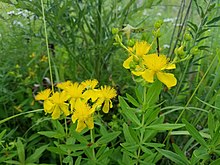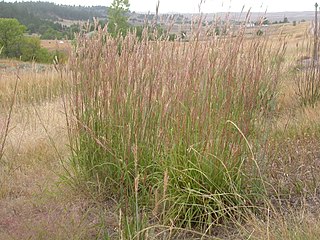
Andropogon gerardi, commonly known as big bluestem, is a species of tall grass native to much of the Great Plains and grassland regions of central and eastern North America. It is also known as tall bluestem, bluejoint, and turkeyfoot.

The Morton Arboretum, in Lisle, Illinois, United States, is a public garden and outdoor museum with a library, herbarium, and program in tree research including the Center for Tree Science. Its grounds, covering 1,700 acres, include cataloged collections of trees and other living plants, gardens, and restored areas, among which is a restored tallgrass prairie. The living collections include more than 4,100 different plant species. There are more than 200,000 cataloged plants.
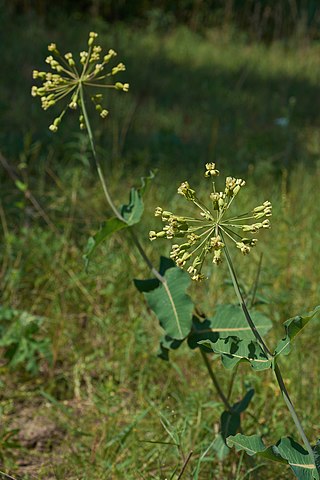
Asclepias amplexicaulis, the blunt-leaved milkweed, clasping milkweed, or sand milkweed, is a species of flowering plant in the subfamily Asclepiadoideae (Apocynaceae). It is endemic to the United States, where it is mostly found east of the Great Plains. It grows in dry prairies, savannas, open woods, and fallow fields, usually in sandy soil.
Herman Silas Pepoon (1860–1941), often known simply as H.S. Pepoon, was a prominent early botanist in the Chicago region. His 1927 Annotated Flora of the Chicago Region remains a classic of Chicago botany.

Carex brunnescens, the brownish sedge or green bog sedge, is a species of plant in the sedge family (Cyperaceae). It has a circumboreal distribution, and is native to North America and Eurasia. In the United States it is primarily found in the Northeast and Midwest extending south into the Appalachian Mountains, with disjunct populations westward in the Rocky Mountains. It has a wide-ranging natural habitat, is in found in forests, bogs, fens, and rock outcrops.

Leucospora multifida, known variously as Obi-Wan conobea, narrow-leaved paleseed, cliff conobea, cut-leaved conobea, or much-cleft conobea, is an annual herb in the plantain family, Plantaginaceae, and the only species in the North American genus Leucospora.
Ulmus × intermediaElowsky is a natural hybrid elm occurring across Nebraska and several other Midwestern states, derived from the crossing of Ulmus rubra and Ulmus pumila. As Red Elm U. rubra is far less fertile, and highly susceptible to Dutch elm disease (:DED), it could eventually be hybridized out of existence by U. × intermedia. The hybrid was first reported from the wild in the Chicago region in 1950 and was provisionally named U. × nothaWilhelm & Ware in 1994.
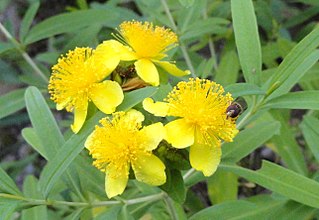
Hypericum kalmianum, commonly called Kalm's St. Johns wort or Kalm's St. Johnswort, is a flowering plant in the St. John's wort family Hypericaceae. It is native to the Great Lakes region in the northern United States and southern Canada. Hypericum kalmianum was named after its discoverer, Swedish botanist Pehr Kalm (1715-1779).
Floristic Quality Assessment (FQA) is a tool used in the United States to assess an area's ecological integrity based on its plant species composition. Floristic Quality Assessment was originally developed in order to assess the likelihood that impacts to an area "would be irreversible or irretrievable...to make standard comparisons among various open land areas, to set conservation priorities, and to monitor site management or restoration efforts." The concept was developed by Gerould Wilhelm in the 1970s in a report on the natural lands of Kane County, Illinois. In 1979 Wilhelm and Floyd Swink codified this "scoring system" for the 22-county Chicago Region.
Gerould S. Wilhelm is an American botanist and lichenologist. He is known as author of several floras of the Chicago Region and the development of the Floristic Quality Assessment methodology, a tool to assess the integrity of natural areas. He is the director of research at Conservation Research Institute, a nonprofit organization "dedicated to the promotion of planning, design, restoration, and long-term management of sustainable ecological systems in built and natural environments through applied research, education, and outreach."

John Carey was a British botanist who studied in North America between 1830 and 1852. Carey was a "frequent guest and invaluable companion" to Asa Gray. Carey revised Gray's proofs of the first edition of the Manual of the Botany of the Northern United States, also contributing articles on Salix (willows), Populus (poplars), and Carex (sedges). In his obituary, Gray described Carey as "a near and faithful friend, an accomplished botanist, a genial and warm-hearted and truly good man."

Hypericum swinkianum, known as Swink's St. John's wort, is a shrub in the St. John's wort family. It was named after Chicago Region botanist Floyd Swink (1921-2000).

A remnant natural area, also known as remnant habitat, is an ecological community containing native flora and fauna that has not been significantly disturbed by destructive activities such as agriculture, logging, pollution, development, fire suppression, or non-native species invasion. The more disturbed an area has been, the less characteristic it becomes of remnant habitat. Remnant areas are also described as "biologically intact" or "ecologically intact."
Laura Rericha-Anchor is an American biologist with expertise in botany, ornithology, entomology, and ecology of the Midwestern United States.
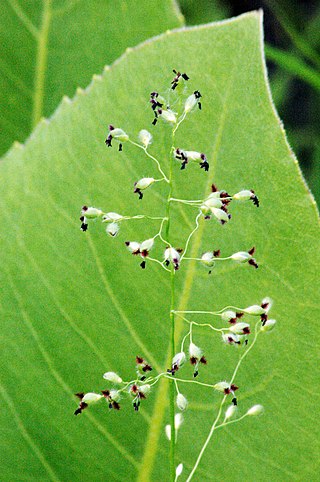
Dichanthelium leibergii, known as variously as Leiberg's panicum, Leiberg's panicgrass, Leiberg's rosette grass, and prairie panic grass is a species of grass native to North America. It was named for its discoverer, John Bernhard Leiberg (1853-1913), a Swedish-born American botanist active in the western United States.

Asclepias lanuginosa, the woolly milkweed or sidecluster milkweed, is a species of flowering plant in the dogbane family, Apocynaceae, native to central Canada and the upper Midwest United States. It was described in 1818. It is a perennial herb that grows 6–12 inches (15–30 cm) tall.
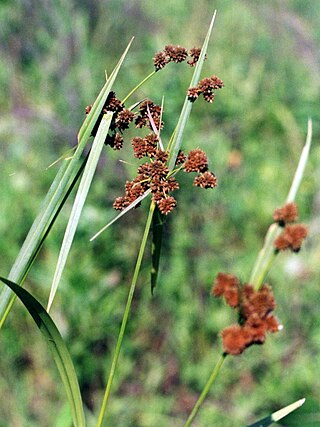
Scirpus atrovirens, known as dark-green bulrush, is a perennial sedge native to wetlands of eastern Canada and the United States. It is sometimes called dark green bulsedge, black bulrush, or green bulrush.

Dasistoma macrophylla, commonly known as mullein foxglove, is a species of flowering plant in the broomrape family. It is monotypic, with no other species in the genus Dasistoma.
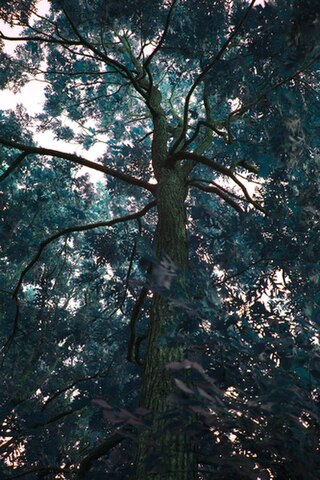
Quercus × bebbiana, known as Bebb's oak, is a naturally occurring hybrid of white oak and burr oak. It occurs where their ranges overlap in the eastern United States and eastern Canada. It was named for Michael Schuck Bebb (1833–1895), an Illinois botanist who specialized in willows (Salix). Its parents are both placed in Quercus sect. Quercus.
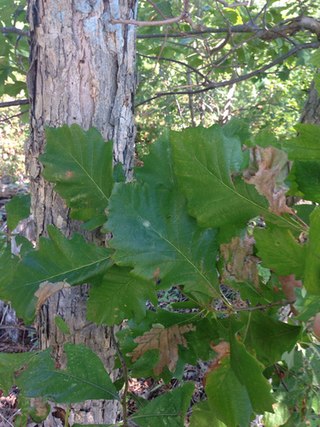
Quercus × deamii, known as Deam's oak, is a naturally occurring hybrid of chinquapin oak and burr oak. It occurs sporadically where their ranges overlap in the eastern United States and eastern Canada. It is named for self-taught botanist and state forester of Indiana Charles C. Deam, who had forwarded samples to William Trelease for description. They thought it to be a cross of Quercus alba and Q. muehlenbergii due to the large numbers of those trees growing in the vicinity. Many sources still reference Q. × deamii as a hybrid of the white oak and chinkapin oak.
